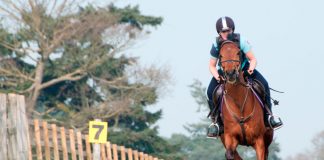Riders generally fall in to two camps with their cantering commitment: unbridled enthusiasm or apprehension that leans towards avoidance. In the case of a horse with a disorganized or rushing canter, riders usually prefer to spend a majority of their time schooling the trot instead. This, unfortunately, does not adapt the body for better canter work but rather strengthens the muscle systems and mechanics associated with trotting. Even though a horse’s canter might lack balance or refinement, it is a disservice to avoid it during daily schooling.
Of all three gaits, canter best strengthens front and hind ends of the horse simultaneously. Because each canter stride requires him to swing forward with both hind legs at once, the lumbar-sacral joint is mobilized more than in walk or trot. The swinging forward of both hind legs hinges the pelvis, causing it to tuck. This in turn rounds the horse’s back. Then, as his leading leg strikes the ground the horse briefly takes more weight on his forelimbs before thrusting his forehand upwards for a moment of suspension.

This rocking motion alternates recruitment of each end of the horse, while pulsing energy through the horse’s spine in an active contraction-relaxation muscle cycle that builds strength without the restriction that accompanies holding a static posture. Moreover, scientists have determined by muscle sensors that cantering involves the fullest, most forceful contraction of the horse’s long back muscles, indicating it might be the best tool for conditioning a weak topline.
Because of the increased motion in the lumbar sacral joint at canter, these long back muscle contractions are able to happen while also pulsing out some of the bunching or tightness that can accompany strength building. In fact, in the case of a horse with a stiff back or overall weakness through his core, it is usually advisable to warm up in the canter rather than the trot. This prevents the longissimus dorsi muscle from holding the back in rigid posture throughout your ride. It allows the horse’s smaller postural muscles deep within the back to balance the spine while the long back muscles do the job they were designed for—free, forward movement.
Liked this article? Here are others you’ll enjoy:
Video: Riding in Different Frames
Video: Feel Your Horse’s Muscle Development
Jec Aristotle Ballou is the author of 101 Dressage Exercises for Horse & Rider.






Good thoughts in this article.